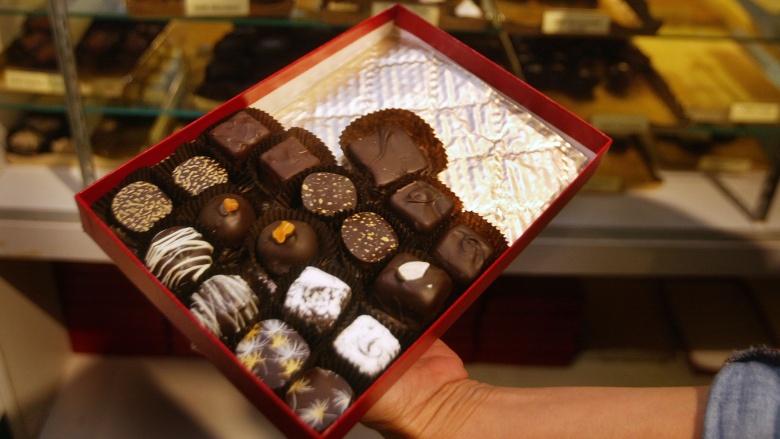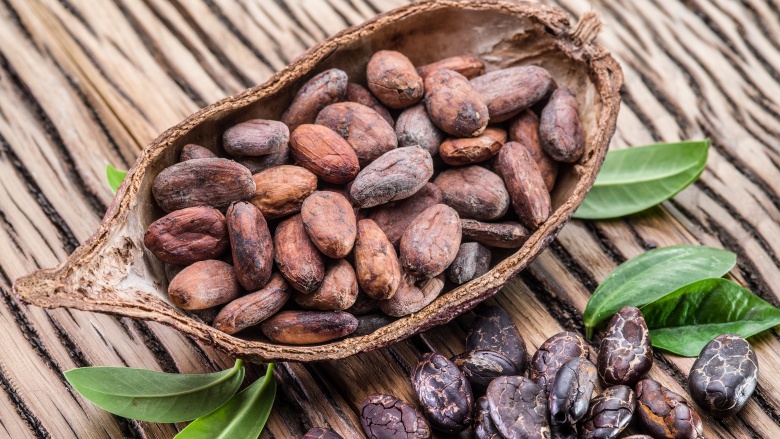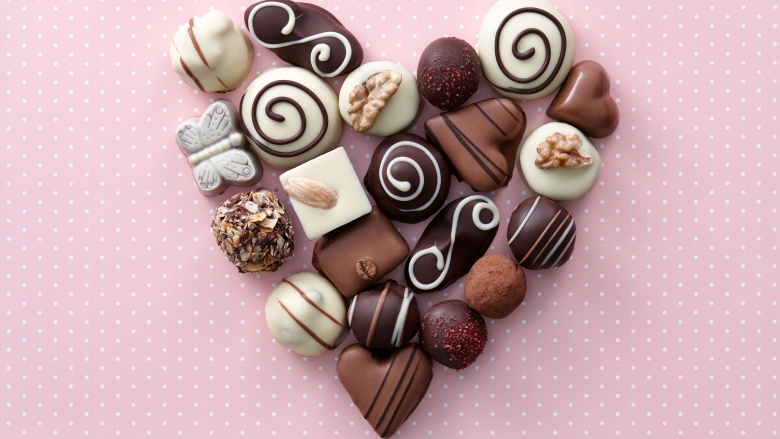Life can get messy and unpredictable sometimes, and some things are just out of our…

The untold truth about chocolate
Will all the chocoholics please stand up? That’s a lot of you — Americans reportedly consume an average of 24 pounds of chocolate per person each year, supporting an $18 billion per year industry. You may be surprised to learn, however, that the sweet chocolate candies and desserts you enjoy today weren’t always such a sweet treat. With a history spanning over 4,000 years, chocolate has traveled a rocky road to become the mass-produced success it is today.
A brief history of chocolate
Evidence of the use and consumption of chocolate by pre-Olmec Mesoamericans has been found dating back as early as 1900 BC, but it was the Mayans of ancient Mexico who put chocolate on the map. The beans of the cacao tree were believed to have divine or magical properties, and were so valuable they were used as currency. The cacao beans were eventually traded with the nearby Aztecs, who adopted the Mayan way of grinding the cacao beans and invented a bitter drink that was believed to have restorative and aphrodisiac qualities. “Xocolatl,” or “the food of the gods,” as the drink was called, was reserved for rulers and priests at sacred ceremonies. It is reported that even sacrificial victims may have been given the elixir before they met their grisly fate, which was likely a very small consolation.
In the 1500’s, the Spanish conquistador Cortes returned to Europe with the exotic cocoa beans. This, along with the addition of cinnamon and honey, helped create a more palatable version of xocolatl, which was enjoyed by royalty and aristocrats. As the thirst for chocolate grew throughout the European elite, colonial plantations were developed in equatorial regions, often worked by Mesoamerican, or imported African, slaves. Chocolate remained a nectar of the wealthy until 1828, when Dutch chemist Coenraad Johannes van Houten invented the cocoa press, revolutionizing the chocolate industry. Van Houten’s invention allowed for mass-produced chocolate that was finally affordable for average folk.
How chocolate is made
The journey from cacao bean to chocolate bar is a long one. The pods of cacao trees, which take up to eight years to mature, are harvested and split open. The beans found inside are sun-dried then removed from their shell, leaving a chocolate “nib.” The nibs are then roasted and crushed, producing the raw chocolate material from which all chocolate products are made. Modern versions of Van Houten’s cocoa press reduce the fat of the nib by over half, resulting in a cake that can be pulverized into a fine powder.
Swiss chemists Daniel Peter and Henri Nestle (sound familiar?) invented a process that makes the chocolate more blendable, and they incorporated powdered milk, resulting in the method for making liquid chocolate that is still used today. The liquid chocolate is then tempered (heated and cooled repeatedly), which gives the resulting chocolate its luster and texture.
The health benefits of chocolate
Chocolate lovers rejoice! Science confirms that chocolate is indeed good for you … provided servings remain small-to-moderate in size, and it’s the right kind of chocolate. In short, the less processing the chocolate goes through, the more the cocoa bean’s natural flavanols are preserved. Flavanols have antioxidant properties, and are proven to lower blood pressure, increase blood flow between the brain and heart, strengthen skin elasticity, and fight inflammation. Higher quality, dark chocolate is your best bet if you are seeking a healthy treat.
Sadly, 2015 reports touting chocolate as a miracle weight loss aid have since been debunked. But the antioxidant thing is still legit, so we can definitely feel good about that.
Is chocolate really an aphrodisiac?
The Aztec ruler Montezuma is said to have downed up to 50 goblets of chocolate a day, to keep up with the demands of his ever-growing harem. But is such a thing even possible, or is the whole “chocolate = aphrodisiac” thing hokum and pipe dreams? Well, chocolate contains a number of chemicals associated with happiness, love, and stamina. When chocolate is consumed, phenylethylamine and serotonin — chemicals which boost mood and energy — are released in the body, which are mildly addicting. Women are more susceptible to these chemicals, which may explain why women are more often “chocoholics.” A traditional romantic gift, men often court women with chocolate, as it’s been believed to lower her inhibitions.
Scientists continue to debate, however, whether chocolate should actually be classified as an aphrodisiac. According to John Renner, founder of the Consumer Health Information Research Institute (CHIRI), “The mind is the most potent aphrodisiac there is. It’s very difficult to evaluate something someone is taking because if you tell them it’s an aphrodisiac, the hope of a certain response might actually lead to an additional sexual reaction.” Aprodisiac or not, though, it’s still delicious, and if deliciousness doesn’t win over a lady, we don’t know what will.
Making chocolates at home
For those intent on making chocolate from scratch, it is possible to purchase raw cacao beans and embark upon a many-day, roasting, grinding, and tempering process. If that sounds like it’ll cramp your weekend plans, a popular chocolate confection amongst home cooks is chocolate truffles. Named for their resemblance to the prized mushroom of the same name, making truffles is surprisingly easy. Chocolate is melted down and blended with corn syrup, cream, and perhaps liqueur. The mixture is then chilled, and scooped into small balls which are then rolled in a variety of coatings, like coconut, cocoa powder, ground nuts, or chopped chocolate. Truffles store well in the fridge or at room temperature, and are a fantastic homemade gift.
How Valentine’s Day Chocolate Came to be a Tasty Tradition
Chocolate has been referred to as “the food of the gods” since the time of the Aztec Indians. In fact the Aztec ruler, Montezuma believed chocolate was an aphrodisiac. Christopher Columbus enjoyed the chocolate he discovered in the Americas. So, he brought it back as a tribute to Queen Isabella of Spain along with other treasures like gold! This new luxury, chocolate, and its legend as an aphrodisiac quickly made its way across the aristocracy of Europe.
In time though, chocolate made its way to the masses. By the 1800s, the Cadbury Brothers had set up shop in England making and selling chocolate to average citizens. In 1861, Richard Cadbury created the first ever heart-shaped box for Valentine’s Day. Thus, began the common link between chocolate and Valentine’s Day. A new tradition had begun.
It might be a marketing strategy of the genius Richard Cadbury of the 19th century that is still hugely successful even to this day and age. The Cadbury brothers used to manufacture chocolate and was looking for a way to utilize cocoa butter that was extracted during the making of chocolate liquor. Richard Cadbury figured out a way to make to chocolate bars that were good in the taste along with being economical. Previously, chocolate was expensive to purchase and the only elite class was able to buy the chocolate from limited resources. Cadbury was able to produce chocolate that was easy on the pockets. His next step was to create beautiful boxes for chocolates with cupid and roses, which were quite popular in Victorian days and were considered as the symbol of romance. Needless to say, his chocolates became palatable and commercialized, thus sold like hot cakes. Cadbury was actually the one who first invented the heart-shaped box of chocolate and changed the Valentine’s Day forever for the generations of lovers.
In America, just at the turn of the century, Valentine’s Day was starting to gain popularity among the youth of that era. Chocolates too were making their presence felt when chocolate pioneers like Milton Hershey first started the commercial production of ‘kisses’, drop sized chocolates, in 1907. But it was Chocolatier Russell Stover who truly made the chocolate linked with romance with the introduction of the heart-shaped box of chocolates. Stover, along with her husband, first started selling chocolates wrapped in heart-shaped boxes in 1923, which quickly took off among the chocolate lovers. Their ‘Secret Lace Heart’, chocolates containing in a chocolate box covered in satin and black lace, was their biggest success. Now, with over 3000 employees and $600 plus in annual sales, Russell Stover is still considered as the best chocolate box selling company in the USA.
Chocolate Fun Facts
1) Modern science has linked the chemical phenylethylamine in chocolate to feelings of excitement, attraction and even pleasure. Maybe Montezuma was indeed onto something. You can decide on that one for yourself.
2) According to HolidayInsights.com, though women make most of the chocolate purchases during the year (75%), men make the most purchases for Valentine’s Day (75%).
3) A survey SuzySaid.com/Acton and The Happy Chocolatier conducted with local women indicated that most wanted the chocolate Valentine’s Day gifts delivered to the home (not work). And, that they would share the treats with their loved ones (great news for the buyer).
So, our guess is that men buy chocolate because it IS part of the Valentine’s Day tradition. And, from what our recent survey found – part of that chocolate giving tradition is now to send the gifts home or to simply bring them home!
4) Chocolate has emotional effect on People
It’s fact that the chocolates have a huge physiological and emotional effect on people. Giving chocolate is not just a sign of love but also given as ways to express delight, initiate desire, expresses your apologies and rekindle friendship, or even given just to simply uplift the mood as it’s a powerful mood enhancer.
5) Chocolate, especially the dark one, is good for health
The darker the chocolate is, the better it is for the health of yours. Dark chocolate contains chemicals that lower the risk of cancer and heart diseases. Dark chocolate is full of antioxidants and flavonoids which fight against the free radicals in the body. Not just that but it also is known to lower the blood pressure and improve the blood flow. Besides health perspective, it is even great for skin as dark chocolate contains bioactive compounds that increase the skin density and hydration. And there is a considerable evidence to say that the dark chocolate improves brain functions as cocoa contains stimulant substance like caffeine and theobromine in small amount. In all, dark chocolate is an all-rounder which is not only great way to express love but also good for the heart (literally!) and provides glow and youth to your face along with boosting your mind capabilities.
In all, the day of love is synonymous with smooth silky richness of chocolate. Hence, eating chocolates might the perfect way to celebrate your love with the rich indulgent goodness. So go ahead and check out chocolate stores as they offer array of scrumptious chocolates that can easily delight your sweetheart on this Valentine’s Day.








